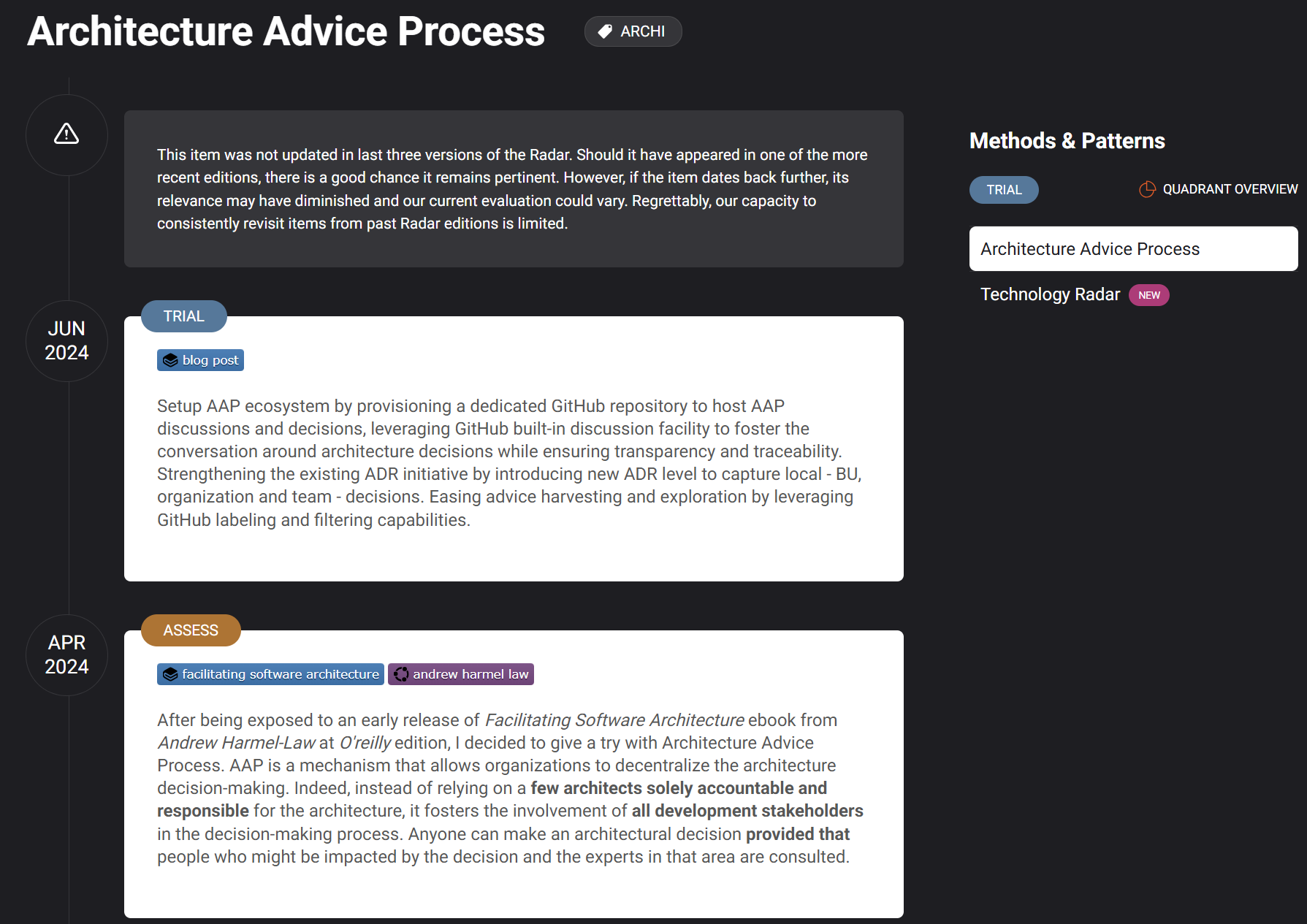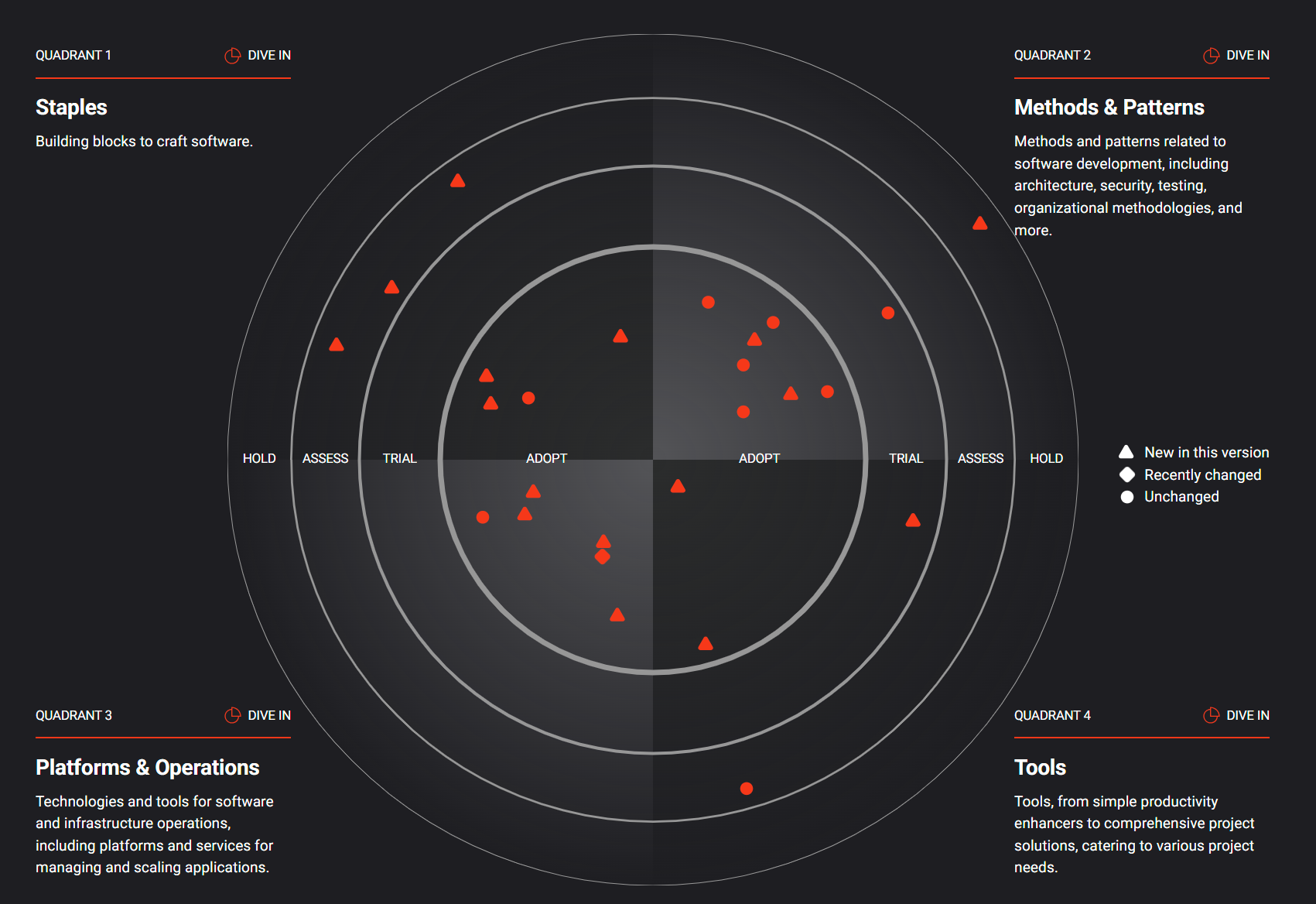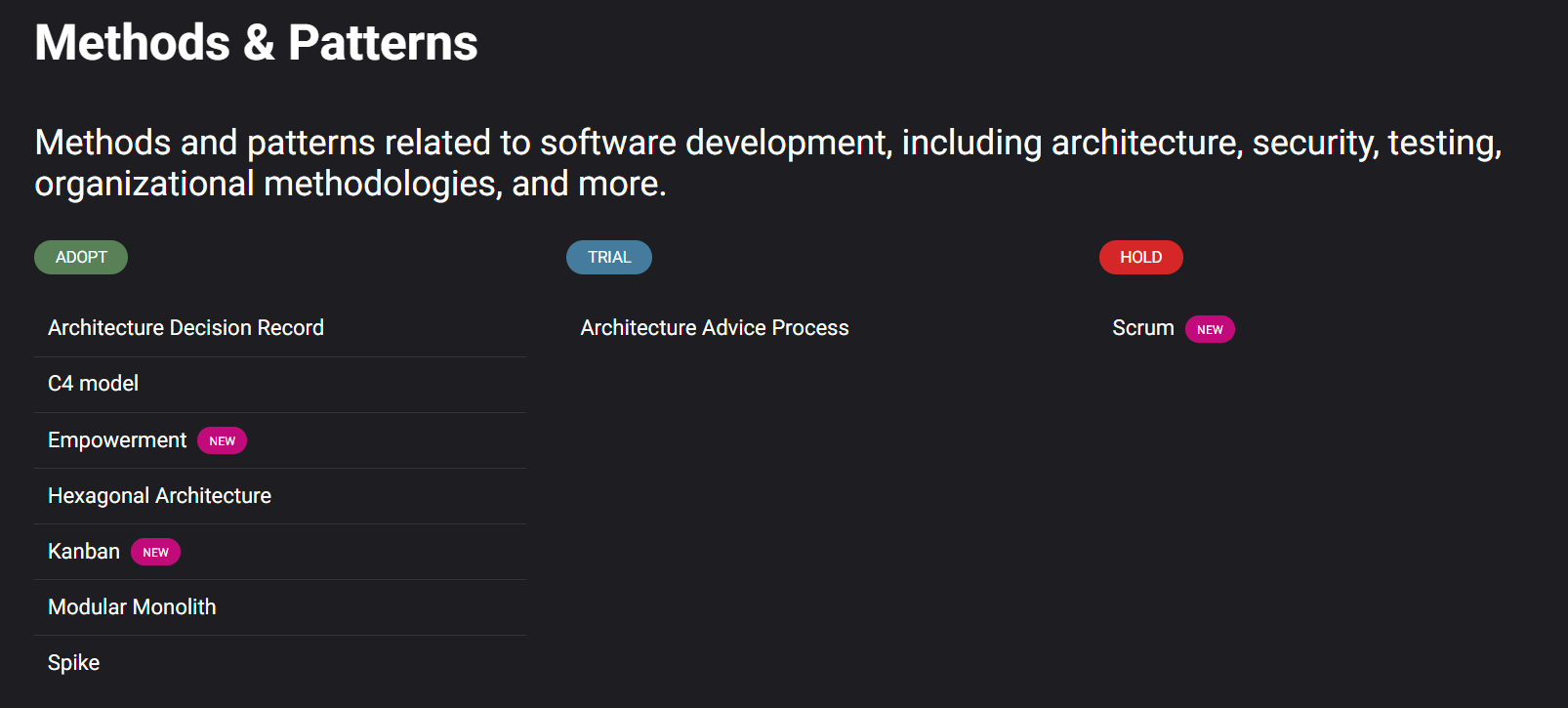To support technical decision-making, the software industry often relies on technology maps, which provide a quick snapshot of the underlying technologies used in the ecosystem while also capturing a contextual and compelling history. This knowledge-sharing tool serves both as a foundation for informing architectural decisions upstream and as an artifact that documents Architecture Decision Record (ADR) outcomes downstream. Combining ADRs with the Technology Radar helps teams communicate more effectively, both internally and externally.
Craft
The Technology Radar is a collaborative effort. Items are contributed by all team members, including developers, architects, and other stakeholders. We advocate to use a Pull Request workflow to propose, discuss, and merge changes to the Technology Radar. Each item is materialized by a self-contained markdown file, with front matter for metadata and a body that documents key lifecycle milestones, especially those supporting decisions to move between rings or to track evolution within a ring.

History is automatically tracked using a timestamped directory structure, and versioning is based on the number of these directories. Each time a new item is added or an existing item is updated, a new directory is created with the current date and time. This allows us to maintain a clear history of changes while also providing a snapshot of the Technology Radar at any given point in time.

Use
Tools, frameworks, and practices we decided to adopt shapes how we build software. In a sense, technology stack contributes to a team DNA. The Technology Radar serves as a living document that reflects our current technology landscape, highlighting the tools and practices we use, their status, and their relevance to our work.
Its purpose is to guide and inspire daily work within the teams. By surfacing honest status updates on our technology stack, it helps us understand what is working well, what needs improvement, and what new technologies we should consider. The Technology Radar is not just a list of technologies; it is a tool for reflection and discussion, enabling us to make informed decisions about our technical direction. Tracking history and evolution of the moving pieces also helps us understand how our technology choices have changed over time, providing valuable insights into our development practices and priorities.
It also aims to provide valuable information and a high-level perspective, enabling more informed and coordinated decision-making. We hope that developers outside our teams will also find the information in our technology overview useful and inspiring.
Cluster
Every data set deserves structure. The Technology Radar is organized into quadrants and rings, which help categorize and assess the technologies we use.

Quadrants
Quadrants can be adapted to team needs, but one common approach is to classify technologies into well-known categories:
- Staples: Building blocks we use to create software. Depending on the context, these can range from programming languages and frameworks to bare-metal STCs or off-the-shelf services.
- Security & Compliance: Technologies and tools that help streamline and enforce security and compliance requirements.
- Platforms & Operations: Technologies related to software operations, infrastructure, and platform tools and services.
- Tools & Patterns: A variety of software tools and patterns, from simple productivity boosters to comprehensive project solutions for different needs.
Rings
An important aspect of the Technology Radar is its rings, which indicate the status and maturity of each technology. The rings help us understand how we view and use different technologies within our teams. Once again, this may be tailored to team needs, but a common approach is to use the following rings:
- Adopt: Technologies we strongly recommend. These have been used extensively within the team and have proven their stability and value. Usually, those are backed by a tech lead or gate who may serve as an evangelist for the technology.
- Trial: Technologies we have successfully implemented and recommend evaluating further. The goal is to examine these more closely with the intention of moving them to the ‘Adopt’ ring.
- Assess: Technologies we have experimented with and find promising. We suggest considering these when you have a specific need in your project. They usually serve as breeding ground when it comes to new ideas and innovation.
- Hold: This unique category advises against using certain technologies going forward. This doesn’t mean they are inherently bad; they may still be acceptable in existing projects. However, we move items here when we believe better alternatives exist. This ring gathers both technologies we used but want to retire and those that we do not plan to use.
Filter
Quadrants and rings represent two dimensions we can filter Technology Radar items by. One can also use tags to provide additional context and thus new dimensions to filter by. Tags can be used to indicate specific characteristics, such as domain technologies belong to or licensing models they use.
By status, across all quadrants
Useful to quickly identify technologies that are in a specific status, regardless of their quadrant. One can also use cardinality of the status to assess team or product maturity. A Technology Radar with many items in the ‘Adopt’ ring and few in ‘Trial’ or ‘Assess’ may indicate a stable and mature technology stack, while a Technology Radar with many items in ‘Trial’ or ‘Assess’ may suggest a team that is actively exploring new technologies.

By quadrant, across all statuses
Useful to quickly identify technologies that are in a specific quadrant, regardless of their status. One can also use cardinality of the quadrants to assess team or product focus. A Technology Radar with many items in the ‘Platforms & Operations’ quadrant and few in ‘Tools & Patterns’ may indicate a team that is focused on infrastructure and operations, while a Technology Radar with many items in ‘Tools & Patterns’ may suggest a team that is focused on productivity and development tools.

By tag, across all quadrants and statuses
Useful to enrich the Technology Radar with additional context and provide new dimensions to filter by. One can use tags for more granular filterings. Focusing on licensing models, for example, can help identify technologies that are more suitable for specific projects or teams. This can be particularly useful when considering open-source vs. commercial solutions or when evaluating the long-term viability of a technology based on its licensing model.

Closing
Technology Radar is a powerful tool for teams to document, share, and reflect on their technology choices. By providing a structured overview of the technologies we use, their status, and their relevance, it helps us make informed decisions about our technical direction. The Technology Radar is not just a list of technologies; it is a living document that evolves with our teams and projects, enabling us to adapt to changing needs and priorities.
